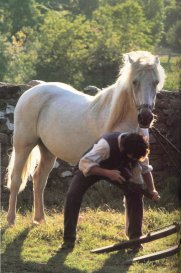
The One Room School House
Memorizing Poems
Land was set aside and a small school was erected by the community for the benefit of all the local children. Teachers were usually just girls from the community. Later high school was a requirement before you could teach, and then two years of college became necessary.
Typical classrooms held at first benches and a wood or coal stove for heat, some slate for a blackboard, little slate boards for each child, some chalk, and some rags for wiping off. A lot of copying from the black board was done to learn the letters, or practice the arithmetic. Memory and memorization were daily events. Everyone memorized the alphabet, the times tables, the days of the week, the months of the year. Every one memorized the Star Spangled Banner, the pledge to the flag.
Poems were memorized, and my mother could recite those poems all her life to me. One of them was:

by Henry Wadsworth Longfellow.
- Under a spreading chestnut-tree
- The village smithy stands;
- The smith, a mighty man is he,
- With large and sinewy arms
- And the muscles of his brawny arms
- Are strong as iron bands.
- His hair is crisp, and black, and long,
- His face is like the tan;
- His brow is wet with honest sweat,
- He earns whate'er he can,
- And looks the whole world in the face,
- For he owes not any man.
This poem was written in 1839. The blacksmith no longer stands in Cambridge but its place is marked with a tablet. When the chestnut tree was cut down the children of Cambridge had an armchair made of the wood and gave it to Mr. Longfellow on his seventy-second birthday.

another poem was:
FROGS AT SCHOOL
by George Cooper
- Twenty froggies went to school
- Down beside a rusy pool;
Twenty little coats of green,
Twenty vests all white and clean.
- "We must be in time," said they,
- "First we study, then we play;
That is how we keep the rule,
When we froggies go to school."
- Master Bullfrog, grave and stern,
- Called the classes in their turn;
Taught them how to nobly strive,
Likewise how to leap and dive.
- From his seat upon a log,
- Showed them how to say, "Ker-chog!"
Also how to dodge a blow
From the sticks which bad boys throw.
- Twenty froggies grew up fast;
- Bullfrogs they became at last.
Not one dunce was in the lot,
Not one lesson they forgot.
- Polished in a high degree,
- As each froggie ought to be,
Now they sit on other logs,
Teaching other little frogs.
A dunce was a child being punished by the teacher for some misdeed during class time, or sometimes, for not knowing their school work. The punishment was to sit or stand in the corner of the room with a cone shaped hat upon their head. It was a shameful experience, made even more disgraceful by the titters of the other children.
Were children unkind to each other back in those early small roomed school houses? I am sorry to say, yes indeed. One naughty story I recall, was gathering bedbugs and keeping them in a little box, and releasing unbeknown to the little girl who was the cleanest most polished little girl in the class, then finding them on her, and announcing it publicly, much to her chagrin.
Most beds were made of straw stuffed into a cloth mattress sack. This sack was then laid upon metal springs. (If you were lucky) Once or twice a year, usually in the spring, our folks would take those springs and mattresses out, and kerosene would be thrown on them and they were burned. New cloth, with new straw mattresses replaced the old, and it got rid of the little critters that had made a home in your mattress. It was one of those things that probably every family dealt with and no one talked about. For having bugs in your clothes, or on your bedding was saying you weren't very clean. No one wanted that stigma. And of course, as is true today, was true then, some people were cleaner than others.

![]()
 Links to other sites on the Web
Links to other sites on the Web
Fandrick Family Home Page by Ron Fandrick
The George Kail Family
 Back to the Home Page
Back to the Home Page
 Next Page
Next Page
 back
back
© 1997 dor_97@yahoo.com
![]()
